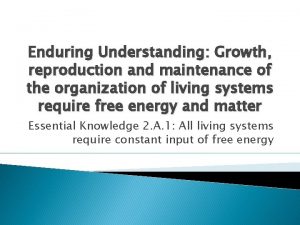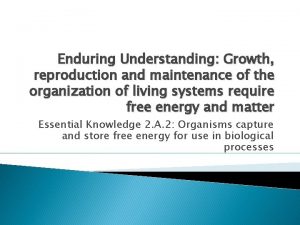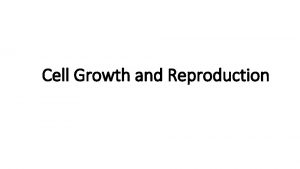Enduring Understanding Growth reproduction and maintenance of the






- Slides: 6

Enduring Understanding: Growth, reproduction and maintenance of the organization of living systems require free energy and matter Essential Knowledge 2. A. 2: Organisms capture and store free energy for use in biological processes

Heterotrophs capture free energy present in carbon compounds produced by other organisms? � How do organisms produce ATP in the absence oxygen? ◦ Fermentation (glycolysis + fermentation = anaerobic respiration) � What type of organisms use fermentation? ◦ Facultative Anaerobes- an organism that makes ATP by aerobic respiration when oxygen is available but switches to fermentation when oxygen is not available ◦ Obligate Anaerobes – carry out only fermentation (anaerobic respiration) and cannot survive in the presence of oxygen

Glucose Glycolysis CYTOSOL Pyruvate No O 2 present: Fermentation Ethanol or lactate O 2 present: Aerobic cellular respiration Acetyl Co. A MITOCHONDRION Citric acid cycle

Heterotrophs capture free energy present in carbon compounds produced by other organisms? � What are the two types of fermentation? ◦ Alcoholic Fermentation ◦ Lactic Acid Fermentation � Is ATP produced during fermentation? ◦ NO – but fermentation allows glycolysis to continue to make a net gain of 2 ATP per glucose by oxidizing NADH to NAD+. ◦ In fermentation as NADH is oxidized a carbon compound is reduced.

Heterotrophs capture free energy present in carbon compounds produced by other organisms? � Pyruvate is converted to ehtanol in two steps ◦ Step 1 releases CO 2 from pyruvate leaving acetaldehyde ◦ Step 2 oxidized NADH to NAD+ and reduced acetaldehyde to ethanol � Occurs in bacteria, yeast, and some plants Alcoholic Fermentation � Pyruvate is converted to Lactacte in one step ◦ Pyrvuate is reduced to lactate as NADH is oxidized to NAD+ � Occurs in bacteria, fungi, and human muscle cells Lactic Acid Fermentation

2 ADP + Pi 2 Glucose 2 ATP Glycolysis 2 Pyruvate 2 NAD+ 2 + NADH 2 H+ 2 CO 2 2 Acetaldehyde 2 Ethanol (a) Alcohol fermentation 2 ADP + Pi 2 Glucose Glycolysis 2 NAD+ 2 Lactate (b) Lactic acid fermentation 2 ATP 2 + NADH 2 H+ 2 Pyruvate











